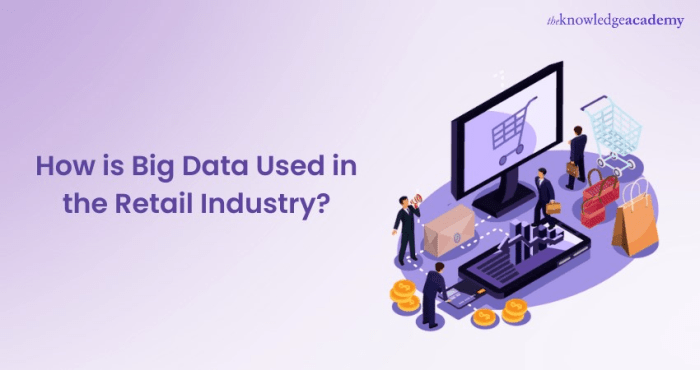Retailers are using big data to understand their customers better than ever before. From analyzing sales figures to tracking website traffic, businesses are collecting mountains of information to personalize experiences and optimize operations. This data-driven approach allows retailers to predict trends, improve inventory management, and ultimately boost profitability. Imagine a world where every purchase, every interaction, every online click contributes to a more efficient and satisfying shopping experience.
This exploration dives into the strategies, applications, and future of big data in retail.
Big data isn’t just a buzzword; it’s a powerful tool transforming the retail landscape. By collecting, analyzing, and interpreting vast amounts of data, retailers gain invaluable insights into consumer behavior. This allows them to tailor marketing campaigns, predict demand, and ultimately enhance the customer journey. From personalized product recommendations to optimized pricing strategies, big data is enabling retailers to create more engaging and profitable experiences.
Big Data in Retail: A Revolution in Understanding Customers
Big data is transforming the retail landscape, enabling businesses to gain unprecedented insights into customer behavior and market trends. It’s no longer just about collecting data; it’s about leveraging that data to make smarter decisions, personalize the customer experience, and ultimately drive sales. This approach moves beyond basic sales figures to encompass a holistic view of the customer journey.Retailers are now able to understand their customers on a deeper level, predicting their needs and preferences, and tailoring products and services accordingly.
This data-driven approach is key to staying competitive in today’s dynamic marketplace.
Types of Data Collected by Retailers
Retailers collect a wide range of data points to understand their customers and operations. This data comes from various sources, including in-store transactions, online interactions, and customer surveys. Understanding these diverse data sources is crucial for a comprehensive view of the customer.
- Sales Data: This encompasses transaction history, product popularity, and sales trends. Analyzing this data helps retailers identify best-selling items, understand seasonal fluctuations, and optimize inventory levels.
- Customer Demographics: This includes age, location, gender, and income. This information allows for targeted marketing campaigns and the development of products and services tailored to specific customer segments.
- Website Traffic: Website analytics provide insights into customer browsing behavior, popular products, and conversion rates. This data helps retailers understand what customers are looking for and how they interact with the online platform.
- Customer Feedback: Surveys, reviews, and social media interactions provide valuable insights into customer satisfaction and areas for improvement. This allows retailers to proactively address customer concerns and enhance their offerings.
Data Analytics for Understanding Customer Behavior
Data analytics is a powerful tool for understanding customer behavior and preferences. By analyzing vast amounts of data, retailers can identify patterns and trends that would be impossible to discern through traditional methods.Retailers use a variety of techniques, including machine learning algorithms, to identify trends in customer purchasing patterns. They can predict future demand, personalize marketing campaigns, and optimize pricing strategies.
This advanced analysis is crucial for improving the customer experience.
Benefits of Big Data for Retailers
Big data offers significant advantages to retailers. By leveraging the insights gained from data analysis, retailers can optimize various aspects of their operations.
| Benefit | Description |
|---|---|
| Improved Inventory Management | Predictive analytics helps optimize stock levels, reducing waste and ensuring sufficient supply of popular items. |
| Personalized Marketing | Targeted campaigns based on individual customer preferences result in higher conversion rates and increased customer engagement. |
| Enhanced Customer Service | Understanding customer needs leads to proactive service, improved resolution of issues, and a better overall experience. |
| Optimized Pricing Strategies | Data analysis helps determine optimal pricing points, maximizing revenue while maintaining competitiveness. |
| Improved Supply Chain Management | Real-time data enables better forecasting and responsiveness to changing market demands. |
Data Collection Methods in Retail

Retailers are increasingly leveraging big data to gain a deeper understanding of their customers and optimize their operations. A critical component of this process is the effective collection of data from various sources. This involves understanding the different methods employed, the ethical considerations surrounding data gathering, and the trade-offs associated with each approach. Choosing the right data collection strategies is crucial for extracting meaningful insights and driving profitable outcomes.Effective data collection is not just about amassing information; it’s about strategically gathering the right kind of information from the right sources.
This allows retailers to paint a comprehensive picture of their customer base, personalize experiences, and anticipate future trends. This in turn enables them to optimize inventory, personalize marketing campaigns, and enhance customer service.
Point-of-Sale (POS) Systems, Retailers are using big data
POS systems are fundamental for collecting transactional data in retail settings. These systems capture details like purchase history, product preferences, and frequency of visits. The sheer volume of data generated by POS systems can be incredibly valuable for understanding purchasing patterns, identifying trends, and optimizing inventory management.
Customer Relationship Management (CRM) Systems
CRM systems provide a centralized repository for customer data, including contact information, purchase history, and interactions with the company. This centralized data allows for targeted marketing campaigns and personalized customer experiences. CRM systems allow retailers to build a detailed profile of each customer, enabling them to tailor offers and services to individual needs.
Online Tracking and Analytics
In the digital age, online tracking plays a crucial role in data collection. Websites and mobile apps collect data on user behavior, including browsing history, product views, and purchases. This data, combined with other sources, allows retailers to understand online customer preferences and tailor online experiences. Retailers can leverage this data to enhance website design, personalize recommendations, and improve customer journeys.
Ethical Considerations in Data Collection
Ethical considerations are paramount in data collection. Retailers must ensure data privacy, obtain explicit consent from customers, and handle sensitive information responsibly. Maintaining transparency about data usage and offering customers control over their information are vital for building trust and maintaining a positive brand image. Retailers must comply with data protection regulations like GDPR and CCPA.
Comparison of Data Collection Methods
Different data collection methods have their own strengths and weaknesses. POS systems are efficient for capturing transactional data, while CRM systems excel at managing customer interactions. Online tracking provides detailed insights into online behavior. The choice of method often depends on the specific needs and resources of the retailer. A comprehensive approach that combines various methods offers the most complete understanding of customer behavior.
Data Source Advantages and Disadvantages
| Data Source | Advantages | Disadvantages |
|---|---|---|
| Point-of-Sale (POS) Systems | Efficient capture of transactional data, real-time insights, detailed purchase history. | Limited information on customer demographics, less detailed on customer preferences, can be siloed data. |
| Customer Relationship Management (CRM) Systems | Centralized customer data, comprehensive customer profiles, targeted marketing, personalized service. | Requires integration with other systems, potentially expensive, may not capture real-time data. |
| Online Tracking and Analytics | Detailed insights into online behavior, personalization of online experiences, website optimization. | Potential for privacy concerns, data security risks, requires skilled analysis, potentially incomplete view of customer behavior. |
Applications of Big Data in Retail Operations: Retailers Are Using Big Data
Big data is transforming retail operations, moving beyond basic customer insights to encompass the entire value chain. By analyzing vast amounts of data, retailers can optimize every step, from stocking shelves to serving customers. This deeper understanding allows for more agile responses to market fluctuations and customer demands. The key is not just collecting data, but extracting actionable intelligence.Retailers are leveraging big data to gain a comprehensive view of their operations.
This data-driven approach allows for better forecasting, improved efficiency, and ultimately, increased profitability. By understanding customer preferences and trends, retailers can anticipate demand and adjust inventory levels accordingly.
Inventory Management Optimization
Retailers use big data to predict future demand with greater accuracy. By analyzing historical sales data, seasonal trends, and external factors like economic indicators and social media sentiment, retailers can forecast demand for specific products with precision. This enables them to optimize inventory levels, preventing stockouts and overstocking. Sophisticated algorithms can also identify slow-moving items and recommend strategies for clearance sales or adjustments in product offerings.
Real-time tracking of inventory across various locations allows for efficient replenishment and prevents bottlenecks in the supply chain.
Supply Chain Efficiency Enhancement
Big data provides valuable insights into the intricacies of the supply chain. By tracking the movement of goods, retailers can identify bottlenecks, delays, and potential risks. Real-time data analysis allows for proactive interventions, minimizing disruptions and maintaining optimal flow. The data can be used to optimize transportation routes, negotiate better deals with suppliers, and predict potential disruptions. This proactive approach improves delivery times, reduces costs, and enhances overall supply chain efficiency.
Enhanced Customer Service
Big data allows retailers to personalize customer interactions and provide tailored support. By analyzing customer purchase history, browsing behavior, and feedback, retailers can anticipate customer needs and proactively offer assistance. This personalized approach fosters loyalty and positive customer experiences. Data-driven insights can also identify areas for improvement in customer service processes and facilitate faster issue resolution.
Personalized Product Recommendations
Big data empowers retailers to provide highly personalized product recommendations. By analyzing customer preferences, purchase history, and browsing behavior, retailers can recommend products that are likely to resonate with individual customers. This tailored approach increases conversion rates and enhances the overall customer experience. Sophisticated algorithms can even anticipate customer needs before they are explicitly expressed.
Table: Retail Operations and Big Data Improvement
| Retail Operation | How Big Data Improves |
|---|---|
| Inventory Management | Predictive demand forecasting, optimized inventory levels, reduced stockouts and overstocking, identification of slow-moving items. |
| Supply Chain Management | Identification of bottlenecks, proactive interventions, optimized transportation routes, improved supplier relationships, enhanced delivery times, reduced costs. |
| Customer Service | Personalized interactions, proactive assistance, improved issue resolution, enhanced customer loyalty, faster response times. |
| Product Recommendations | Highly personalized recommendations, increased conversion rates, enhanced customer experience, anticipation of customer needs. |
| Pricing Optimization | Dynamic pricing strategies based on real-time data, maximizing revenue, and adjusting prices based on competitor actions and customer demand. |
Big Data and Customer Relationship Management (CRM)
Big data is revolutionizing how retailers interact with customers, moving beyond basic transactional data to understand intricate customer behaviors and preferences. This deeper understanding allows for highly personalized experiences, leading to stronger customer relationships and ultimately, increased loyalty and sales. This shift from broad marketing to targeted strategies is a direct result of the ability to analyze vast amounts of data to predict and respond to individual customer needs.Customer segmentation based on behavior and preferences is a key application of big data in CRM.
By analyzing purchase history, browsing behavior, website interactions, and social media activity, retailers can identify distinct customer groups with similar characteristics. This allows for targeted marketing efforts and tailored product recommendations, boosting customer engagement.
Retailers are leveraging big data to understand customer preferences, but a crucial element often overlooked is the impact of compelling visuals. To truly maximize conversions, retailers need hero images that boost conversions, capturing attention and driving engagement. By understanding the psychology of visual appeal, retailers can effectively use big data to craft compelling visuals that drive sales.
hero images that boost conversions are a vital component in this data-driven approach.
Customer Segmentation Techniques
Analyzing customer data through various channels provides a comprehensive view of their behaviors and preferences. Retailers leverage this data to create segments based on demographics, purchasing patterns, and engagement metrics. For example, analyzing purchase history reveals repeat buyers, high-value customers, and infrequent buyers, allowing for distinct marketing strategies. This segmentation allows retailers to tailor messaging and offers, improving conversion rates and customer lifetime value.
Personalizing Marketing Campaigns
Big data empowers retailers to personalize marketing campaigns at a granular level. By understanding individual customer preferences, retailers can send targeted emails with relevant product recommendations, create personalized product displays on websites, and tailor in-store promotions to individual customer needs. This targeted approach not only increases conversion rates but also fosters a stronger connection with the customer. For instance, a customer who frequently purchases organic products might receive targeted promotions on new organic food items.
This level of personalization fosters trust and strengthens the customer relationship.
Retailers are increasingly leveraging big data to personalize customer experiences and optimize their operations. However, this data-driven approach raises crucial questions about the balance between value creation and revenue extraction. Are they truly enriching customer lives, or are they simply optimizing for profit margins? Understanding this delicate interplay is critical to the future of retail. This distinction is explored further in the article on value creation vs revenue extraction , ultimately impacting how retailers use big data to shape their strategies and build lasting customer relationships.
The goal shouldn’t just be maximizing revenue, but building meaningful value for consumers.
Building Stronger Customer Relationships
Big data facilitates the development of stronger customer relationships by providing a more profound understanding of customer needs and preferences. By analyzing customer feedback, reviews, and social media interactions, retailers can identify areas for improvement and address customer concerns proactively. This proactive approach enhances customer satisfaction and loyalty, leading to positive word-of-mouth referrals. For example, if a large number of customers express dissatisfaction with the checkout process, retailers can use big data to identify the specific pain points and implement solutions to improve the customer experience.
Anticipating Customer Needs and Preferences
Big data enables retailers to anticipate customer needs and preferences. By tracking trends in customer behavior and preferences, retailers can predict future purchasing patterns and proactively offer relevant products and services. For example, if a significant portion of customers are searching for winter coats in the early autumn, retailers can stock up on these items in advance, ensuring that customers have access to the products they need when they need them.
Customer Segmentation and Targeting
| Customer Segment | Characteristics | Big Data Targeting Strategies |
|---|---|---|
| Loyal Customers | High frequency of purchases, high average order value | Exclusive offers, early access to sales, personalized recommendations based on past purchases |
| New Customers | First-time buyers, unknown preferences | Targeted onboarding campaigns, introductory discounts, personalized welcome messages with tailored product suggestions |
| High-Value Customers | High lifetime value, significant contributions to revenue | Exclusive events, VIP treatment, personalized concierge services, tailored product recommendations based on past purchases |
| At-Risk Customers | Decreased purchase frequency, lower engagement | Personalized communication to re-engage, special offers to encourage return, personalized product recommendations based on past preferences |
| Competitor Customers | Previously purchased from competitor retailers | Highlight unique selling propositions, offer competitive pricing, highlight superior product features or service |
This table illustrates how big data can be used to identify distinct customer segments and develop targeted strategies to effectively engage each group. The tailored approach enhances customer satisfaction and builds stronger, more profitable customer relationships.
Big Data and Pricing Strategies
Big data is revolutionizing retail pricing strategies, moving beyond traditional methods to dynamic, data-driven approaches. By analyzing vast amounts of customer data, retailers can gain a deeper understanding of price sensitivity, optimize pricing models, and ultimately maximize profitability. This allows for more personalized experiences and more accurate predictions, leading to improved sales and customer satisfaction.Retailers are increasingly recognizing the power of big data to refine pricing strategies.
The ability to tailor pricing to individual customer segments and react to real-time market fluctuations is crucial for competitiveness and profitability in today’s dynamic marketplace. This sophisticated approach, leveraging big data, empowers retailers to optimize their pricing models for maximum return on investment.
Determining Optimal Pricing Strategies with Big Data
Big data enables a more nuanced understanding of consumer behavior. By analyzing historical sales data, browsing history, purchase patterns, and demographics, retailers can identify trends and preferences that influence price sensitivity. This data-driven approach empowers retailers to create more targeted pricing strategies. Machine learning algorithms, trained on vast datasets, can predict demand curves and optimal pricing points for specific products or customer segments.
Identifying Price Sensitivities of Different Customer Segments
Retailers can segment customers based on their purchasing behavior and price sensitivity. For instance, analyzing past purchases can reveal which customers are more likely to respond to discounts or promotions. These insights can be used to develop targeted pricing strategies for different customer groups. By tailoring pricing to specific segments, retailers can maximize their revenue and improve customer satisfaction.
This can involve offering premium prices to customers who are less price-sensitive or offering discounts to those who are more price-sensitive.
Creating Dynamic Pricing Models
Dynamic pricing models, adjusted in real-time based on demand and supply, are becoming increasingly prevalent. These models utilize big data to track real-time market conditions, including competitor pricing, inventory levels, and demand fluctuations. Sophisticated algorithms, often incorporating machine learning, can dynamically adjust prices to maximize revenue based on these real-time inputs. This approach is particularly effective in industries like travel and hospitality, where demand fluctuates significantly.
Examples of Data-Driven Pricing Adjustments
Retailers have effectively used big data to adapt pricing strategies based on real-time market conditions. For example, an online retailer might adjust the price of a popular product based on real-time competitor pricing, demand, or inventory levels. During peak seasons or special events, prices can be increased to capture higher demand. Conversely, if inventory levels are high, prices might be lowered to encourage sales.
This agility is crucial for remaining competitive in a fast-paced market.
Comparing Pricing Strategies
| Pricing Strategy | Description | Effectiveness with Big Data | Examples |
|---|---|---|---|
| Fixed Pricing | Same price for all customers, regardless of demand or segment. | Limited effectiveness; big data can identify opportunities for price optimization. | Bulk purchases, commodity goods. |
| Dynamic Pricing | Prices adjusted in real-time based on demand, competitor pricing, and other factors. | High effectiveness; big data allows for precise adjustments to maximize revenue. | Airline tickets, hotel rooms, event tickets. |
| Value-Based Pricing | Pricing based on perceived value to the customer. | High effectiveness; big data helps understand customer perception and adjust prices accordingly. | Luxury goods, unique products. |
Challenges and Limitations of Big Data in Retail

Big data offers immense potential for retail businesses, but its implementation isn’t without hurdles. Successfully leveraging this technology requires a nuanced understanding of the obstacles that can arise, from security concerns to the complexities of data interpretation. This section delves into the challenges and limitations of big data in retail, highlighting crucial aspects that retailers must address for successful adoption.
Security Risks Associated with Big Data
Retailers amass vast amounts of customer data, including sensitive information like credit card details and personal preferences. This data presents significant security risks if not properly protected. Breaches can lead to substantial financial losses, reputational damage, and legal repercussions. Data encryption, access controls, and regular security audits are crucial to mitigate these risks. Implementing robust cybersecurity measures is paramount for protecting sensitive customer information and maintaining trust.
Challenges in Managing and Interpreting Large Volumes of Data
Retailers often face the challenge of processing and analyzing the sheer volume of data generated daily. This includes transactional data, customer interactions, social media activity, and more. Storing, processing, and extracting meaningful insights from these massive datasets requires specialized infrastructure and expertise. Furthermore, interpreting this complex data to identify trends, predict customer behavior, and optimize business strategies is a significant undertaking.
Effective data management and analytical capabilities are essential for unlocking the full potential of big data.
Potential Biases in Data Sets and Mitigation Strategies
Data sets can reflect existing societal biases, leading to skewed insights and potentially unfair or discriminatory outcomes. For instance, if a retailer’s data primarily comes from a specific demographic, their understanding of customer needs and preferences may be incomplete. Retailers must actively work to identify and address these biases in their data collection and analysis processes. This includes diversifying data sources, employing diverse teams, and utilizing techniques to detect and correct for bias.
Employing a variety of data sources and cross-referencing data points can help reduce bias and ensure a more accurate understanding of customer needs.
Retailers are increasingly leveraging big data to understand customer preferences. This translates into highly personalized experiences, like sending behaviorally targeted emails. For example, check out these behaviorally targeted emails examples to see how specific customer actions trigger tailored messaging. Ultimately, this data-driven approach allows retailers to create more effective marketing campaigns and boost sales.
Need for Skilled Data Analysts and Specialists
Successfully leveraging big data requires specialized skills in data analysis, interpretation, and visualization. Retail organizations need to invest in training and development programs to cultivate in-house data expertise. This includes hiring skilled data scientists, data analysts, and data engineers to manage and analyze the data effectively. These individuals are crucial for identifying patterns, extracting insights, and developing strategies based on data-driven decisions.
The need for skilled professionals is further emphasized by the growing complexity of data analysis techniques.
Summary of Challenges and Limitations of Big Data Implementation in Retail
| Challenge | Explanation |
|---|---|
| Security Risks | Protecting sensitive customer data from breaches is critical. Robust security measures and encryption are essential. |
| Data Management | Processing and analyzing large volumes of data requires specialized infrastructure and expertise. |
| Data Bias | Data sets may reflect existing societal biases, potentially leading to inaccurate insights. Diversification and mitigation strategies are needed. |
| Skilled Personnel | Retail organizations require data analysts and specialists to manage, interpret, and utilize the data effectively. |
Future Trends in Big Data and Retail
Retailers are increasingly recognizing the transformative power of big data. Moving beyond basic analytics, the future of retail hinges on harnessing emerging technologies to create truly personalized customer experiences and optimize every aspect of the business. From supply chain management to pricing strategies, big data is evolving from a tool to a core competency. This shift demands a proactive approach to adapting to the constant evolution of data analysis techniques and their applications.
Emerging Technologies in Big Data Analysis
Big data analysis is constantly evolving, driven by innovations in machine learning, artificial intelligence, and cloud computing. These technologies empower retailers to process and interpret massive datasets more efficiently and extract deeper insights. The increasing availability of powerful computing resources and sophisticated algorithms facilitates the development of more sophisticated predictive models and real-time insights. For instance, advancements in natural language processing (NLP) allow retailers to understand customer sentiment and preferences from online reviews and social media conversations, leading to improved product development and marketing strategies.
Artificial Intelligence and Machine Learning in Retail Operations
AI and machine learning are revolutionizing retail operations in numerous ways. These technologies are being employed to automate tasks, optimize inventory management, personalize customer experiences, and enhance supply chain efficiency. For example, AI-powered chatbots can handle customer inquiries 24/7, freeing up human agents to address more complex issues. Machine learning algorithms can predict demand fluctuations, enabling retailers to optimize inventory levels and reduce waste.
Further, AI can identify patterns in customer purchasing behavior, enabling the creation of highly personalized product recommendations and targeted marketing campaigns.
Future of Data-Driven Decision Making in Retail
Data-driven decision-making is poised to become even more critical in the future of retail. Retailers will rely on real-time data analysis to respond quickly to market trends and customer preferences. This agility will be crucial in navigating the rapidly changing retail landscape. The ability to analyze vast amounts of data will allow retailers to anticipate customer needs, optimize pricing strategies, and personalize offerings on a scale never before possible.
Real-time data analysis will be essential for managing inventory, predicting demand, and optimizing logistics.
Innovative Applications of Big Data in Retail
Retailers are already implementing innovative applications of big data to enhance their operations and customer experiences. Personalized product recommendations are becoming increasingly sophisticated, leveraging machine learning algorithms to understand individual customer preferences and predict future purchases. This leads to a higher conversion rate and increased customer satisfaction. Furthermore, retailers are utilizing big data to optimize pricing strategies in real time, dynamically adjusting prices based on demand, competitor actions, and inventory levels.
Future Trends in Big Data and Their Implications
| Future Trend | Potential Implications for Retailers |
|---|---|
| Advanced Machine Learning Models | Enhanced predictive capabilities, leading to improved inventory management, personalized recommendations, and optimized pricing strategies. |
| Real-time Data Analysis | Increased agility in responding to market fluctuations, improved customer service, and enhanced operational efficiency. |
| AI-powered Chatbots and Virtual Assistants | 24/7 customer support, personalized interactions, and reduced wait times for customers. |
| Predictive Maintenance | Reduced downtime for equipment, lower maintenance costs, and improved operational efficiency. |
| Enhanced Customer Segmentation | Development of highly targeted marketing campaigns, personalized product offerings, and improved customer retention strategies. |
Last Recap
In conclusion, retailers are leveraging big data to gain a competitive edge in the ever-evolving marketplace. From improving inventory management to enhancing customer relationships, the applications are vast and impactful. While challenges like data security and analysis exist, the potential benefits of this data-driven approach are significant. The future of retail is undoubtedly intertwined with big data, and retailers who embrace this technology are well-positioned for success.





